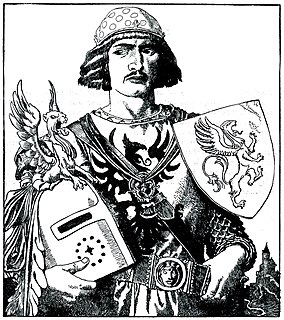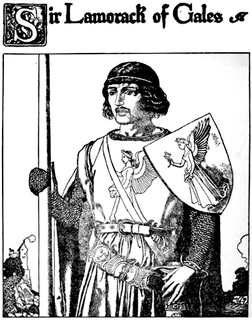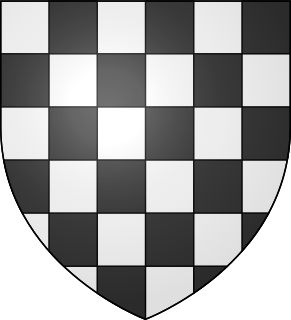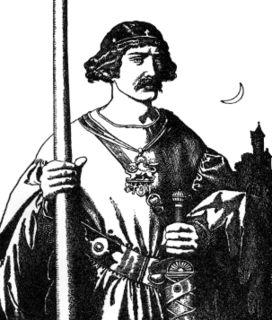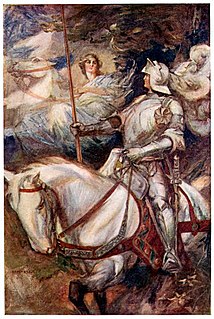This article needs additional citations for verification .(December 2009) (Learn how and when to remove this template message) |
Sir Calogrenant,[ pronunciation? ] sometimes known in English as Colgrevance, or, in ancient Welsh, Cynon ap Clydno , is a Knight of the Round Table in Arthurian legend. He is a cousin to Sir Ywain, and his courtesy and eloquence were known throughout the kingdom.

Cynon ap Clydno or in some translations Kynon or Cynan was an Arthurian hero from Welsh mythology. His quest to the Castle of Maidens and his subsequent trial against the Black Knight, serve as a prelude to the adventure of Owain and The Lady of the Fountain. Cynon is closely associated with Sir Calogrenant, who takes his role in other versions of the tale.

The Round Table is King Arthur's famed table in the Arthurian legend, around which he and his knights congregate. As its name suggests, it has no head, implying that everyone who sits there has equal status. The table was first described in 1155 by Wace, who relied on previous depictions of Arthur's fabulous retinue. The symbolism of the Round Table developed over time; by the close of the 12th century it had come to represent the chivalric order associated with Arthur's court, the Knights of the Round Table.
Calogrenant first appears in Chrétien de Troyes' Yvain, the Knight of the Lion . After a good meal, Calogrenant tells a story to a group of knights and Queen Guinevere about an adventure he had in the forest of Brocéliande. He had heard of a magic spring in those woods which could create a huge storm whenever someone poured its water into a nearby basin. With directions from a local family and a gruesomely depicted giant, Calogrenant reached the spring and summoned the storm. Immediately after the storm, a knight named Esclados attacked him for causing such havoc. The knight soundly defeated Calogrenant, but didn't kill him. Calogrenant's cousin Ywain is upset that Calogrenant never told him of this defeat, and sets out to avenge him, embarking on the adventure that sets up the remainder of events in the romance.

Chrétien de Troyes (1135?-1185?) was a late-12th-century French poet and trouvère known for his writing on Arthurian subjects, and for originating the character of Lancelot. Chrétien's works, including Erec and Enide,Lancelot, the Knight of the Cart, Perceval, the Story of the Grail, and Yvain, the Knight of the Lion, represent some of the best-regarded of medieval literature. His use of structure, particularly in Yvain, has been seen as a step towards the modern novel.
Yvain, the Knight of the Lion is an Arthurian romance by French poet Chrétien de Troyes. It was written c. 1180 simultaneously with Lancelot, the Knight of the Cart, and includes several references to the narrative of that poem. It is a story of knight-errantry, in which the protagonist Yvain is first rejected by his lady for breaking a promise, and subsequently performs a number of heroic deeds in order to regain her favor. The poem has been adapted into several other medieval works, including Iwein and Owain, or the Lady of the Fountain.

Brocéliande is a legendary enchanted forest that had a reputation in the medieval imagination as a place of magic and mystery. Brocéliande is featured in several medieval texts, mostly related to the Arthurian legend and the characters of Merlin, Morgan le Fay, Lady of the Lake, and some of the Knights of the Round Table. It first appeared in literature in the Roman de Rou chronicle by Wace in 1160 and today is most commonly identified as Paimpont forest in Brittany, France.
Calogrenant appears later in the Lancelot-Grail Cycle as an excellent knight, though his kinship to Ywain is not as clear as in Chrétien. He dies during the Grail Quest while trying to keep Sir Lionel from killing his own brother, Bors. Bors had faced a dilemma over whom to rescue between Lionel, who was getting beaten with thorns by two rogue knights, and a maiden who had just been abducted, and chose the maiden over his brother. Lionel was not pleased by this, and attacked Bors the next time he saw him. A religious hermit tried to intervene, but was killed accidentally in the process, and Calogrenant stepped in. Bors would not fight his brother, and Lionel slays Calogrenant and goes after Bors until God steps in and renders him immobile.

The Lancelot-Grail, also known as the Vulgate Cycle or the Pseudo-Map Cycle, is a major source of Arthurian legend written in French. It is a series of prose volumes that tell the story of the quest for the Holy Grail and the romance of Lancelot and Guinevere. The major parts are early 13th century, but scholarship has few definitive answers as to the authorship. An attribution to Walter Map is discounted, since he died too early to have been the author.
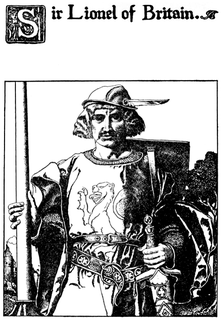
Sir Lionel is the younger son of King Bors of Gaunnes and Evaine and brother of Bors the Younger in Arthurian legend since the Lancelot-Grail cycle. He is a double cousin of Lancelot and cousin of Lancelot's younger half-brother Ector de Maris.
Bors is the name of two knights in the Arthurian legend, one the father of the other. The two first appear in the 13th-century Lancelot-Grail romance prose cycle. Bors the Elder is the King of Gaunnes (Gannes/Gaunes/Ganis) during the early period of King Arthur's reign, and is the brother of King Ban of Benoic and the father of Bors the Younger Lionel. His son Bors the Younger later becomes one of the best Knights of the Round Table and even achieves the Holy Grail.
Thomas Malory recounts Calogrenant's death scene in his Le Morte d'Arthur , but also includes another one later in the narrative. Despite dying on the Grail quest, he turns up as one of the twelve knights who help Agravaine and Mordred trap Lancelot and Guinevere together. Lancelot has no armor or weapons, but he pulls Calogrenant into the room and kills him, and uses his sword to slay the rest of the company (though Mordred escapes).
Sir Thomas Malory was an English writer, the author or compiler of Le Morte d'Arthur. Since the late 19th century, he has generally been identified as Sir Thomas Malory of Newbold Revel in Warwickshire. Occasionally, other candidates are put forward for authorship of Le Morte d'Arthur.

Le Morte d'Arthur is a reworking by Sir Thomas Malory of existing tales about the legendary King Arthur, Guinevere, Lancelot, Merlin, and the Knights of the Round Table. Malory interpreted existing French and English stories about these figures and adds original material. Malory's actual title for the work was The Whole Book of King Arthur and His Noble Knights of the Round Table, but after Malory's death the publisher changed the title to that commonly known today, which originally only referred to the final volume of the work.

Mordred or Modred is a character who is variously portrayed in the Arthurian legend. The earliest known mention of a possibly historical Medraut is in the Welsh chronicle Annales Cambriae, wherein he and Arthur are ambiguously associated with the Battle of Camlann in a brief entry for the year 537. His figure seemed to have been regarded positively in the Welsh tradition and may have been related to that of Arthur's son.
Roger Sherman Loomis and others speculated that Calogrenant was used specifically as a foil for Sir Kay in some lost early version of the Yvain story. In Chrétien's romance he is presented as everything Kay is not: polite, respectful, and well-mannered. By this theory, his name can be deconstructed to "Cai lo grenant", or "Cai the grumbler", which would represent another opposite characteristic of Kay, who was famous for his acid tongue.
Roger Sherman Loomis was an American scholar and one of the foremost authorities on medieval and Arthurian literature. Loomis is perhaps best known for showing the roots of Arthurian legend, in particular the Holy Grail, in native Celtic mythology.

In Arthurian legend, Sir Kay is King Arthur's foster brother and later seneschal, as well as one of the first Knights of the Round Table. In later literature he is known for his acid tongue and bullying, boorish behavior, but in earlier accounts he was one of Arthur's premier warriors. Along with Bedivere, with whom he is frequently associated, Kay is one of the earliest characters associated with Arthur. Kay's father is called Ector in later literature, but the Welsh accounts name him as Cynyr Ceinfarfog.
Calogrenant appears in the Welsh Romance Owain, or the Lady of the Fountain as Cynon, known elsewhere in Welsh tradition as the lover of Owain's sister Morvydd. Cynon is stated to be the son of Clydno, possibly connected to Clyddno Eiddin. [1]

